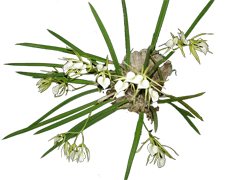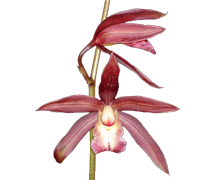Mounted Orchid Care
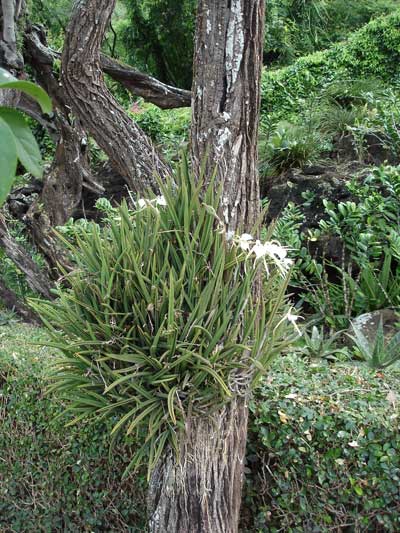
There is something really special about mounted orchids. Seeing the orchid grow as it would in nature, as an epiphite clinging to a tree, is a new, fun, and educational way to experience an orchid's growth. One fairly common orchid that really enjoys living on a mount is Brassovola Nodosa, also known as the "Lady of the Night" for its delightful evening fragrance. The Brassavola Nodosa orchid to the right is growing happily on a tree in a garden in Kauai, Hawaii. In tropical conditions growing mounted orchids is easy, one might even argue it is easier than growing them in a pot. It is easy when there is ample water and humidity such as in a tropical garden, outdoors in warm climates or in a greenhouse. It is not as easy inside a home. It is difficult to keep a mounted orchid watered enough when it is grown inside a home, especially in dry air during the heating season. There is also the logistical challenges of bringing it somewhere like a sink to water it and where and how to hang the mount.
Brassavola is a wonderful addition to an orchid collection but it often becomes unruley in a pot. Its thin pseudobulbs are topped with rigid terete leaves that are often pointy and sharp at the end. These pseudobulbs have a habit of growing every which way at random rather than the more controlled growth patterns of other orchids. They will happily crawl out, over, and around the side of a pot. In addition, Brassavola Nodosa can quickly grow ill in pot culture if the media becomes too sodden for too long. For us they seem especially intolerent of poor conditions in a pot yet grow happily on a mount, even tolerating dry conditions longer and better than our other mounted orchids will.
Orchid Roots and Mounts
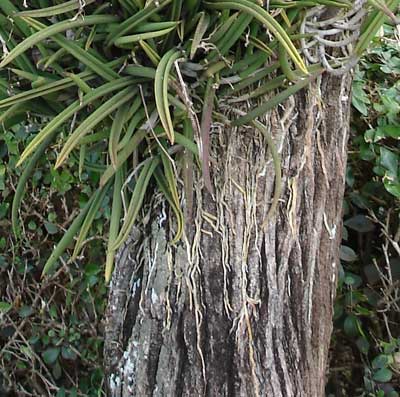
In this closeup photo we can see how the orchid roots love to grow along and cling to the tree bark. Other than terrestrial orchids, this is how orchids grow. Growing in a pot must seem strange to the plant in comparison. This particular tree, with its craggy bark, is a classic spot for a happy orchid. We can see how the roots follow the uneven surface, finding support and water among the crevices. Orchid roots grown in a pot are round but mounted they flatten to grasp the mount.
The classic mount for orchids is cork which is available in plaques of varying sizes. Some orchids, particularly those with thin roots such as oncidium are fond of tree fern mounts and we see their roots growing all the way through them. A branch from a tree that has been trimmed can make a good mount, we really like to set an orchid in the crook of a branch when possible. Hardware cloth makes a simple, spartan mount. Wood slat plaques look something like the flat bottom of a vanda basket and can be used either as a vertical or horizontal mount.
Mounts for Orchids
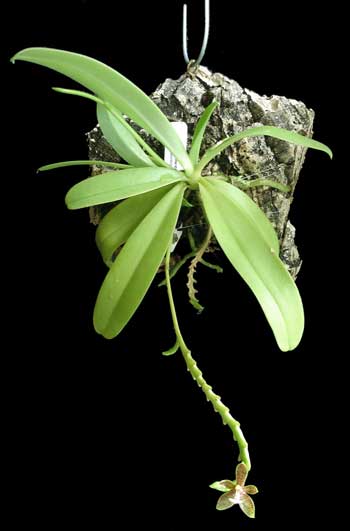



Mounting orchids seems strange but is really fairly easy to do. The first thing is to find a suitable mount. In our view the easiest mount to work with is the traditional cork mount. The next thing is to choose how to secure the plant to the mount. Virtually anything can be used to secure the orchid to the mount with the goal being that after a year or so the orchid will be attached to the mount and the support can be removed. To secure an orchid to its mount one can use string, fishing line, plastic plant ties, even cut up pieces of panty hose, glue or staples. It comes down to the personal preference of aesthetics and ease of use. We like the look of fishing line which is a bit hard to tie but the finished look is worth it. Once the plant has established itself on the mount the fishing line can be cut and carefully pulled away from under and around the roots.
Last, but not least, is to find an orchid to mount. Don't choose a favorite orchid to experiment on at first. Some genera take to mounting in cultivation easier than others, we would recommend starting with brassavola, oncidium, or dendrobium. Phals can be mounted, and we grow some species that way in our greenhouse, but it is challenging to provide the humidity they require especially in home culture. But, if their needs can be met, phals are very beautiful mounted.
A Tale of Two Orchids
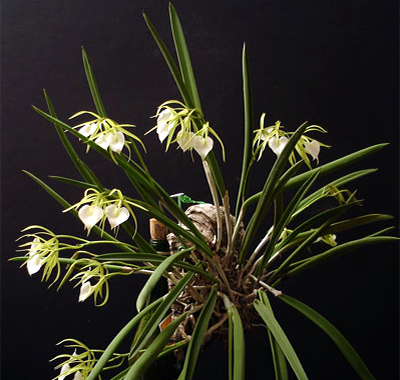
We were growing two identical Brassavola orchids, both in pots. At repotting time we chose to divide one of them and put the two divisions on mounts and repot the other. The two mounted plants have done very well and within a few years were nearly the size of the undivided plant.
The picture to the left and below are these two orchids.
How to Mount an Orchid
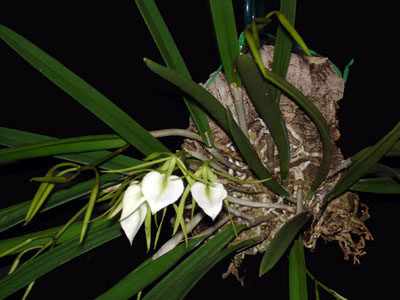
The first step is to prepare the mount that you have selected. Usually some type of hook needs to be secured to the mount to allow it to hang. We like to put two screws or eyelets in the sides of a cork mount with wire between them in much the same fashion as a picture frame is hung with wire. The next step is to decide whether to use a pad of sphagnum moss with the mount. We like to use a small amount of moss both beneath the roots and on top of them when initially mounting a plant. This increases moisture and seems to reduce the shock of transferring from pot culture to mounted culture. Over time the moss falls off or can be pulled off once the orchid is adjusted and firmly attached to its mount. Next take the orchid (which has been removed from its pot and the roots cleaned of old media) and hold it against the mount. Try to place it so that the orchid will be able to grow in its natural direction up the mount. Once established, the orchid will not come off the mount. We have a mounted Oncidium that has grown up so far as to have left the top of its mount and we had to secure an additional mount above the old one for it to continue growing up. Ideally a large enough mount should be chosen to last the orchid for some years.
Practical Considerations
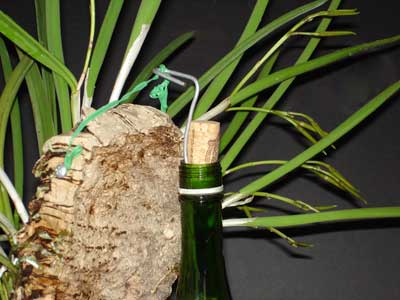
Mounted orchids need to hang somewhere. In a greenhouse they are typically hung from the rafters or from installed rods or mesh screening. In the home it is more of a challenge. One approach is to wedge the mount into a clay pot or vanda basket for support. Another approach is to take a wine or soda bottle and fill it with sand. Put a wire stake or phal hook down into the bottle with part sticking out the top. Stabilize the hook by replacing the cork in the bottle, wedging it in firmly. This provides a nice support for a mount.
Watering
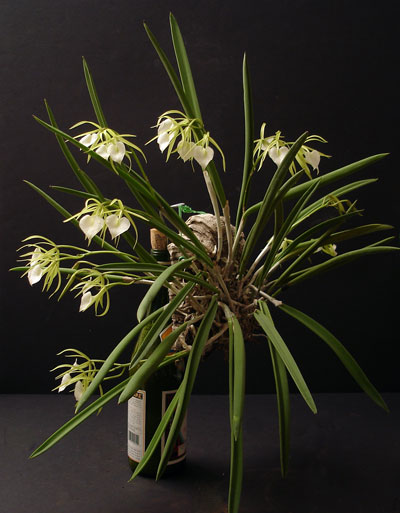
Mounted orchids want to be watered frequently, daily is often required in the home. While they can go for a few days without water this puts stress on the plant. Water needs are highly dependant on the amount of light, heat, air movement and humidity and so it is difficult to give good guidelines except to say that mounted orchids require considerably more frequent watering than their potted counterparts do. The practical consideration here is that if the plant is indoors it must be taken regularly to the sink for watering. With a bottle support the entire mount and bottle can go into the kitchen sink to be watered. Mounts like to get nice and wet so let the water run for at least a few minutes. The plant shown to the right has been on its mount for 3 years, it is one of the divisions discussed above.
